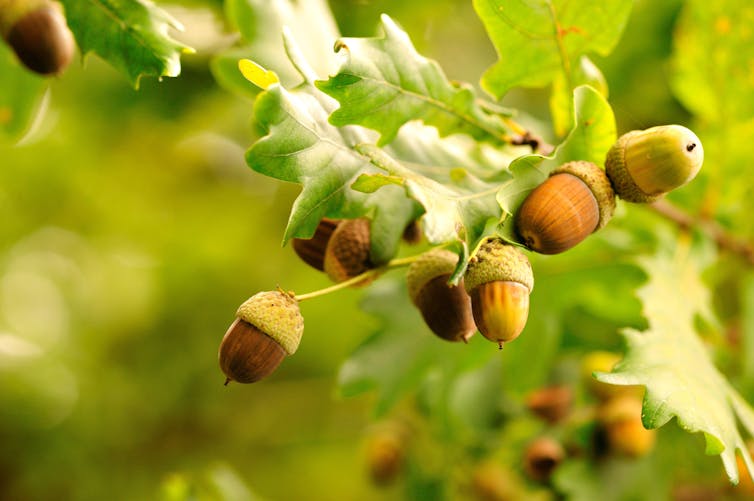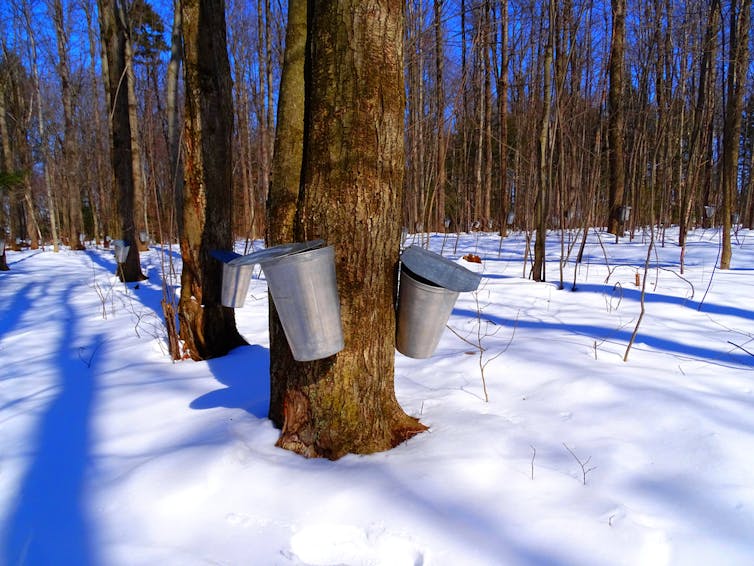While it is true that individual trees are immobile, as a species they can actually move and migrate as well as birds do! However, this takes place over a much different time frame.

This article is part of La Conversation Canada’s series The boreal forest: A thousand secrets, a thousand dangers
La Conversation Canada invites you to take a virtual walk in the heart of the boreal forest. In this series, our experts focus on management and sustainable development issues, natural disturbances, the ecology of terrestrial wildlife and aquatic ecosystems, northern agriculture and the cultural and economic importance of the boreal forest for Indigenous peoples. We hope you have a pleasant — and informative — walk through the forest!
This is what we will explore in this article, the first in our new summer series. As researchers in forest ecophysiology, we study basic tree physical functions and relate them to broader ecological dynamics. Rapid climate change is challenging the sustainability of forest ecosystems in many ways. To deal with the new problems associated with climate change, we need new tools: “assisted tree migration” is one of these.
And to inspire us, this excerpt from a song by Québec poet Gilles Vigneault:
I planted an oak tree at the end of my field,
will I lose my sorrow?
Will I lose my time?
Let’s get the definitions out of the way first: assisted migration refers to the “human-assisted movement of species in response to climate change.” We usually associate the term ‘migration’ with the movement of people or the seasonal flights of birds.
We don’t typically think about forest migration, however, and it may even seem weird to associate these two terms. After all, trees are typically rooted to the ground and don’t move. Or do they?
The moving forest
Tree migration occurs through seed dispersal, and the germination and establishment of new seedlings. After some time, these seedlings will start producing new seeds and contribute to this slow geographical expansion.
Migration strategies may differ among tree species. For example, maple samaras are wind-carried seeds that can travel faster and further than the acorns of an oak tree, limited by their heavy weight. However, new seedlings require years, often decades to grow and produce seeds that can migrate further than their parents.
This movement, which takes place over a period of centuries — generally too slow for our conception of time — can become limiting in the face of rapid human-induced changes in climate systems.

(Shutterstock)
Fast changes, slow trees
Current climate change is quickly modifying environmental conditions. No natural warming event in the past has occurred at a comparable rate. Such rapid changes are putting great pressure on forest ecosystems, particularly by modifying habitat conditions.
The migration speeds of the vast majority of tree species are slower than the shift of favourable habitats. This means that their migration to new favourable habitats (e.g. cold regions in the north becoming warmer) will not compensate for the loss of habitats in other areas (e.g. warm regions in the south becoming drier).
This mismatch between changing habitat conditions and natural tree migration entails a loss of forest vigour. A decline is predicted for many tree species, which may in turn jeopardize local forest ecosystems.
Helping trees migrate
We are being called upon to find strategies to help forests adapt to new climatic conditions. This motivates researchers and forest managers to consider new approaches to solving this problem, including assisted migration.
Artificial seed transfer and planting can accelerate the natural migration process and help overcome geographical barriers, such as mountain ranges or large water surfaces. Assisted migration could therefore be used to help maintain functional forest ecosystems in the future. This is not only important for the conservation of species, but also for the maintenance of all the services forests provide, from wood production to carbon sequestration from the atmosphere.
In general, short-distance relocation is easier to achieve, while longer-distance migration requires careful planning. Since the latter presents higher ecological risks, it is generally only considered for the conservation of endangered species.
But enough theory, let’s move on to concrete examples.
A Canadian example
The sugar maple (Acer saccharum) is an iconic tree species in Canada. As climate change intensifies, sugar maples in the southern portion of the range are suffering from increased competition from trees that are more tolerant to warmer, drier conditions, such as American beech (Fagus grandifolia).
At the same time, researchers have found that areas near the northern limit of maple’s range are becoming increasingly suitable for this species. In this case, assisted migration could help northern forests adapt faster to new conditions, and provide valuable services such as maple syrup production. So why not just go ahead with the technique?
Pioneers
In 2019, the University of Québec in Chicoutimi (UQAC) established an experimental sugar maple plantation at the northern edge of its range, in the Saguenay region of Québec. The experiment is being conducted in partnership with a local family farm, which has chosen to dedicate part of its land to scientific research and the vision of a productive sugar bush for future generations.
The plantation, counting 500 young trees issued from several populations in Québec and the United States, will celebrate its fourth year of life in the spring of 2024. In a few decades, excellent maple syrup may be produced here, in addition to all the valuable scientific data collected up to that point.

(Shutterstock)
Trials on migration
Similar studies have been conducted by the DREAM-Québec research network, a project of the Québec government (Ministry of Natural Resources and Forests), the U.S. Forest Service and Laval University. The experiments consist of mixed plantations of a dozen tree species, located in the Portneuf region of Québec and in Wisconsin in the United States. Here, the effects of factors such as microclimate, herbivore browsing and plant competition on tree establishment and growth can be tested. In addition, the performance of trees from southern populations — adapted to conditions similar to the predicted future climate — can be compared with that of local populations.
This type of experimental study provides valuable information on the characteristics that can help or hinder the success of assisted migration projects. For example, we can understand which species or populations are more sensitive to late frost events or browsing by herbivores.
Implementing scientific trials today can help us fully understand the dynamics and risks of assisted migration, so that we can make the best forest management choices for future years and generations.
Climate change is progressing rapidly and forests don’t move at the same rate, so it is important to begin planting tomorrow’s forests.
The authors would like to thank Emilie Champagne of the Direction de la recherche forestière du Québec (Ministry of Natural Resources and Forests) for her contributions and comments on the article, and Jardins Gobeil for their collaboration and assistance in maintaining the experimental site.




